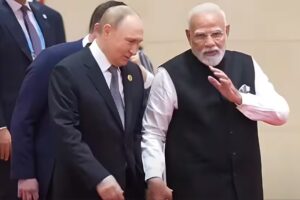
At the start of 2025, analysts reflected on the trajectory of the Belt and Road Initiative (BRI) more than a decade after its launch. Years of massive overseas lending brought China to an unfamiliar role of being a major creditor to many of its BRI partner countries struggling with debt, forcing it to provide bailouts and shift its development finance strategy towards more sustainable projects. However, recent data shows that BRI investments are nonetheless racing ahead at record-high levels, and government actors continue to promote the initiative with the help of foreign media.
A study published last week by Christoph Nedopil in partnership with Griffith University’s Asia Institute and Fudan University’s Green Finance & Development Center outlined these trends. The study found that China’s investments and construction contracts in BRI countries during the first six months of 2025 soared to $124 billion, compared to only $122 billion in all 12 months of 2024. Here are some highlights from the executive summary:
2025 H1 saw the highest BRI engagement ever for any 6-month period, with USD 66.2 billion in construction contracts and about USD 57.1 billion in investments;
China’s energy-related engagement in 2025 was the highest in any period since the BRI’s inception, reaching USD 42 billion, an increase of 100 per cent compared to 2024 H1;
Oil and gas engagement surged to record highs of about USD44 billion, higher than in all of 2024, particularly through oil/gas processing facilities construction contracts in Nigeria (USD 20 billion);
Green energy engagement reached new records with USD 9.7 billion in wind, solar, and waste-to-energy projects and an installed capacity of about 11.9 GW of green energy;
[…] Africa and Central Asia topped the rank of BRI engagement, reaching USD 39 and USD 25 billion, respectively (unseating the Middle East);
[…] Since its establishment in 2013, cumulative BRI engagement reached USD 1.308 trillion, with about USD 775 billion in construction contracts, and USD 533 billion in non-financial investments. [Source]
Last December, Xi Jinping said the BRI had entered a “new phase” that should combine its traditional large infrastructure projects with new “small and beautiful” projects that would reduce risk for both China and partner countries. Eric Olander at the China-Global South Project wrote this week that the report “raises some important questions” about what many have interpreted as a scaling-back of the BRI. He concluded, “‘Small and beautiful’ may be a part of the new BRI, but it is by no means the defining trait of what appears to be a rapidly expanding global infrastructure and energy development initiative.” At The Financial Times, Joe Leahy and other researchers emphasized the surprising growth and large scale of the BRI this year:
“The surge in Chinese engagement this year is surprising, even against the backdrop of steadily growing BRI activity since Covid,” said Christoph Nedopil Wang, the study’s author. “What sets 2025 apart is the scale: multiple megadeals each exceeding $10bn.”
Wang said slow domestic growth and the need to diversify supply chains and markets due to the trade war sparked by Trump’s tariffs had prompted some Chinese companies to look abroad, while BRI countries saw “an opportunity to deepen ties with China amid shifting global geoeconomic dynamics”.
[…] Other researchers also said their calculations showed an increase in BRI deals.
US-based Rhodium Group said that announced foreign direct investment by Chinese entities in BRI countries was worth nearly $15.9bn in the first quarter, up 10 per cent from the same period a year earlier.
Rhodium said south-east Asia accounted for much of the investment momentum in BRI countries as companies sought to diversify their production bases from China. [Source]
Other signs also point to a resurging BRI. In May, Rhodium published a report describing how Chinese investment in Europe rebounded to 10 billion euros in 2024, rising 47 percent from the previous year. Hungary (a BRI signatory) accounted for 31 percent of all Chinese foreign direct investment in Europe, the highest share of any country, while the combined share of Germany, France, and the U.K. (non-BRI signatories) dropped significantly. More recently, in late June, Chinese Premier Li Qiang urged the Asian Infrastructure Investment Bank to increase its support for the BRI.
On the media front, the BRI’s backers have long struggled to “tell China’s story well,” but their efforts continue. Sunday concluded the 2025 Belt and Road Journalists Forum, a week-long event in Jiangxi that attracted around 100 journalists from 50 countries. The guests were treated to cultural performances and thematic field trips to numerous cities, and some were given awards for their work related to China. Jiangxi Daily and other Chinese state-affiliated media outlets provided glowing coverage of the forum, and pointed out that foreign journalists “spoke freely” about their observations. Solange Ayanone, Vice President of Rwanda Journalists Association, was quoted in the China News Service as saying, “For me, this is more than a media visit. Now I understand that China’s greatness stems not only from its economic achievements, but also from its cultural confidence and historical depth.”
However, some of these cultural encounters betrayed a degree of shallowness and exoticization, as seen in this unironic description from a Global Times piece boasting about how the forum “opens up [a] window for overseas reporters to explore the real China”: “In Hanxi village, Jingdezhen, [French photographer and CGTN Francais collaborator Yann] Vernerie excitedly documented the villagers’ faces and their serene rural life, sharing the images on his portfolio website. In the caption of one photo, he wrote: ‘This 75-year-old man stood proudly at his doorstep, showing us the tea leaves he harvested this year. We had barely any time to talk, but his eyes told us of the harvest to come. This man knows the value of work – and the value of seasons.’”
Independent of the actual benefits that the BRI has provided to partner countries, the 2025 Belt and Road Journalist Forum was presented in Chinese state media as primarily a tool for boosting China’s image among foreign audiences. From Liu Jiangqiao in China Daily:
Wang Gang, deputy head of the Publicity Department of the CPC Central Committee, in his speech at the opening ceremony, highlighted the importance of people-to-people exchanges in the joint building of the China-proposed Belt and Road Initiative.
[International media agencies can] promote people-to-people exchanges, deepen mutual understanding, and help lay a strong foundation of public support for the joint development of the BRI, Wang said.
[…Stanley Bangura Junior, chairman of the Sierra Leone Broadcasters Association,] criticized that misleading reports about China in Western media have fueled discrimination and bias in Western societies.
“Through cultural exchanges, face-to-face engagement, and sustained dialogue, we can open new doors and offer the world a more accurate understanding of China,” he said. [Source]





